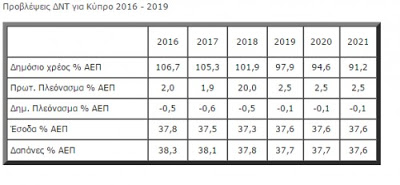The Cypriot public debt will fall below 100% of GDP in 2019, according to the International Monetary Fund, which continues to follow a more conservative course compared to the corresponding forecasts of the Ministry of Finance.
According to the data of the Fiscal Monitor October 2016, which was published today, the IMF estimates that in 2019 the public debt of Cyprus will fall to 97,9%, while the Ministry of Finance, which adopts forecasts for higher growth rates (and higher income), estimates that the debt in the same year will fall to 95,8%.
In relation to the primary balance, the IMF considers that in 2016 it will amount to 2,0% compared to 2,3% which is the corresponding forecast of the Ministry of Finance, while from 2017 onwards the Fund follows a forecast for a lower course that continues until 2020.
The same is true for the fiscal balance (including debt service costs) with the IMF showing a marginally negative picture by 2020, in contrast to the Ministry of Finance, which predicts that in 2019 the fiscal balance will be positive 0,7 %, in contrast to a deficit of 0,1% of the IMF.
In addition, the IMF estimates that pension expenditure for 2015 2030 will increase by 4% (data obtained from the EU Ageing report 2015).
Global debt at a record high
According to the IMF, the debt of the whole world (governments, households and businesses) amounts to 225% of world GDP, which is at the highest point of all time.
Among the advanced economies, the highest public debt in 2016 is presented by Japan with 250% of GDP, followed by Greece with 185%, Italy with 133% and Portugal with 128% of GDP. The USA follows with 108%. The average debt in the euro area in 2016 is projected to reach 92% of GDP.
Although the debt is not evenly distributed across the states, the IMF warns that the size of the debt alone "could set the stage for an unprecedented leverage process that will hamper fragile economic recovery."
It also notes that it is difficult to achieve substantial leverage without strong growth rates and without returning to normal levels of inflation, and points to the need for well-designed and well-targeted government intervention.
The IMF also points to the need to maintain fiscal margins so that there is room for government counter-cyclical intervention.
In relation to countries where inflation is below target then there should be a supportive monetary policy but also a financial policy that motivates banks to recognize losses and correct their balance sheets.
Source: KYPE


